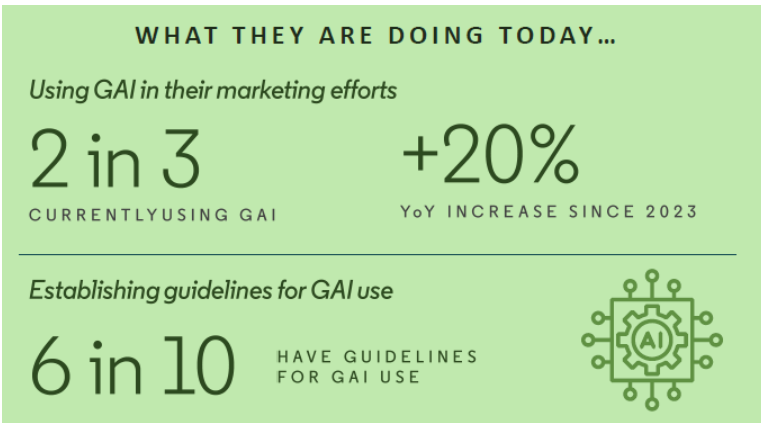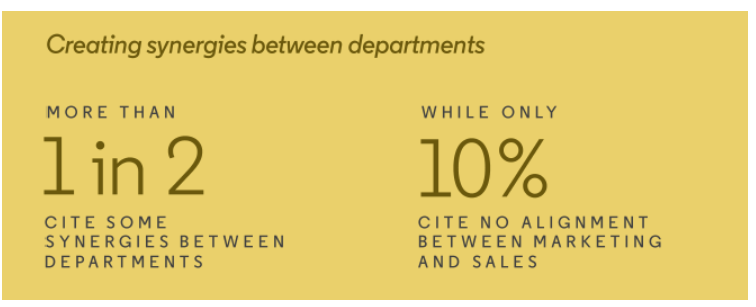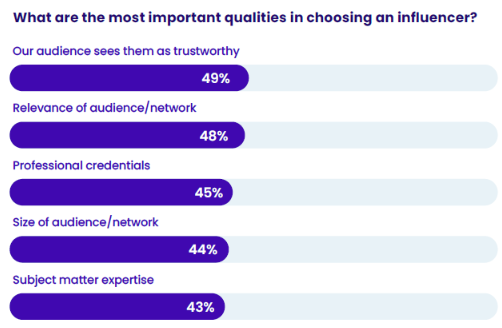B2B thought leadership shows potential buyers that your brand is a credible authority. It helps keep you top of mind even when a buyer isn’t in market yet. Essentially, it earns equity that will mature into sales and repeat business.
The 2024 Edelman-LinkedIn B2B Thought Leadership Impact Report shows that thought leadership is more crucial now than ever. The report says that 90% of decision makers are more likely to be receptive to sales and marketing outreach from companies that produce high-quality thought leadership. More than half of CEOs and other decision makers spend an hour or more per week reading thought leadership content.
But there’s a catch: The overall quality of thought leadership isn’t filling these decision makers’ hunger for new and useful ideas. Only 15% of those surveyed said the quality of thought leadership they read is “very good” or “excellent.” This represents a major opportunity to do thought leadership better than your competition.
What Makes B2B Thought Leadership the Most Effective?
The term ‘thought leadership’ can mean everything from ‘scrupulously sourced original research’ to ‘an opinion article from our CEO.’ Here’s how to make sure yours fits your potential buyer’s definition of great thought leadership.
What is B2B thought leadership?
B2B thought leadership is content created to showcase a company’s unique insights, ideas and best practices. It’s intended to provide meaningful value to a specific audience in order to build relationships with potential buyers.
You can contrast thought leadership content with:
- How-to/educational content (practical but not necesssarily insightful)
- Entertainment content (Engaging but not useful from a business standpoint)
- Promotional content (intended to promote your solution’s benefits and features)
What business purposes does B2B thought leadership serve?
At first glance, thought leadership seems like a purely top-of-funnel tactic. But when it’s executed properly, it can affect business outcomes all the way through the buyer journey. It can:
- Build share of mind. Research shows that 95% of your potential buyers are not in-market at any given time. Thought leadership keeps your brand in their thoughts until they’re ready to research.
- Build credibility. Brand awareness is a good first step. Making sure people associate your brand with smart, novel and useful ideas is the next part of the journey.
- Establish reciprocity. Offering value is a key way to build relationships with potential buyers. Great thought leadership is a gift that can inspire people to give back.
- Ward off competitors. If your brand isn’t putting out quality thought leadership, you’re at risk from a brand that is. Great thought leadership inoculates your existing customers against pitches from competitors.
- Drive more sales and premium pricing. In the Edelman-LinkedIn study, 60% said good thought leadership makes them willing to pay a premium to work with an organization, and 86% said they’d be likely to invite a thought leader company to participate in the RFP process.
With this list of benefits, it’s not hard to see why B2B companies are prioritizing thought leadership. But it takes a strategic effort to hit the mark for high-quality content that earns these results.
Four essential elements for great B2B thought leadership
Great thought leadership can take many forms: Videos, ebooks, resource hubs, and even social media posts. Regardless of the format, these elements can elevate your thought leadership above the rest.
Cites credible data
Original research is the holy grail of credible data; if your team has the resources to partner with a credible researcher to produce a brand-exclusive report, you’re golden.
Even if you can’t create your own report, however, you can still establish credibility through the sources you use. Look to peers in the industry, research firms like Forrester and Edelman, and public resources like government agencies to inform your thought leadership.
Includes NOVEL insights
Too often, brands forget the ‘leader’ part of thought leadership. It’s easy to write a detailed piece on the current best practices in your industry—easy enough that anyone could do it and already has.
True thought leadership should question the status quo, suggest new ways of doing things, or explore how and why the current methods are successful and how they can be optimized. It doesn’t always have to be contrarian or reactionary, but it does need to be something new.
Speaks from experience
If a grocery store clerk wrote a book about being a successful CEO, their conclusions might seem suspect. Ditto if a CEO wrote a book about being a better grocery store clerk. In either case, speculation and supposition are no substitute for actual, lived experience.
In other words, if you’re trying to write useful content for CEOs, your C-suite should be contributing their own insights. If your executives aren’t keen on writing their own content, try for at least a brief interview or two that can inform your drafting.
Is genuinely helpful
I vividly remember the first eBook I downloaded as a newbie marketer. It promised useful insights on marketing—something I desperately needed. But it was mostly platitudes and a heaping helping of brand promotion. This type of “helpful” content is all too common.
Truly helpful content begins with the intention of being helpful. Ask yourself: How will this content benefit someone who has never bought from us, and may never buy from us in the future? Starting with this question ensures your content will be useful to potential buyers as well.
How to develop a thought leadership strategy
Here’s a quick overview of how to approach thought leadership planning, conception, creation and promotion.
#1 Understand your audience
Conduct market research to understand the needs, challenges, and interests of your audience. Use keyword research, social listening, input from your customer service and sales departments, and direct customer feedback to inform your personas.
#2 Define your objectives
Determine what you want to achieve with your thought leadership efforts. Common goals include raising awareness, share of voice, engagement with thought leadership content, and even sales leads generated.
Key metrics for top-of-funnel might include website traffic, social media interactions, new social media followers, and content shares. Lower-funnel metrics might include lead quality, the ratio of MQLs converted to SQLs, and increase in repeat business.
#3 Identify key topics and themes
A mix of internal and external sources can help ensure your content is relevant, knowledgeable and topical. Tap into the knowledge and experience of your executive and managerial teams, as well as those on the front lines with your customers.
You can augment that internal research with external—look at competitors’ content, third-party research and social media posts from industry leaders.
#4 Create high-quality content
Outline a schedule for content creation and publication, ensuring consistency and variety in formats (blogs, whitepapers, webinars, podcasts, etc.). It’s better to publish a smaller amount of higher-quality content at a less frequent cadence than to opt for speed and quantity over quality.
It’s also crucial to ensure your content has useful, actionable advice designed to help your audience excel at their work.
#5 Engage and collaborate
One easy way to expand your reach and help establish credibility is to partner with industry influencers, guest bloggers, and other thought leaders.
As your content earns comments and engagement, continue to interact with your audience and encourage them to participate in a dialog. These conversations can help fuel the next round of thought leadership content.
#6 Promote across channels
It’s important that the right audience sees your thought leadership—without promotion, even the best content can fail to connect. Start by optimizing text content for SEO. Then use social media to share the content organically, and consider paid promotion for more relevant reach.
LinkedIn is most likely the best place to sponsor your content. You’re most likely to find the executive audience you’re looking for on their platform.
#7 Monitor and adjust
As with any content, it’s important to track performance and continually optimize. It’s a good idea to supplement your quantifiable metrics with actual audience feedback.
It’s also important to make thought leadership a long-term commitment. It takes value and consistency to build credibility and stake out real estate in your audience’s minds.
Take the lead with your potential buyers
Ask anyone on the sales team: Relationship-building is a key part of turning browsers into buyers into repeat customers. Thought leadership can help kickstart a profitable relationship by showing buyers exactly who they should be working with.
Need help with content that converts? Explore our content marketing services.
The post What Makes B2B Thought Leadership Actually Work? appeared first on TopRank® Marketing.


